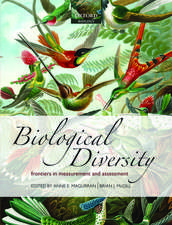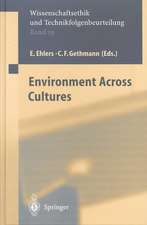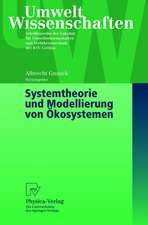Lichens to Biomonitor the Environment
Autor Vertika Shukla, D.K. Upreti, Rajesh Bajpaien Limba Engleză Paperback – 27 aug 2016
| Toate formatele și edițiile | Preț | Express |
|---|---|---|
| Paperback (1) | 637.93 lei 6-8 săpt. | |
| Springer India – 27 aug 2016 | 637.93 lei 6-8 săpt. | |
| Hardback (1) | 644.18 lei 6-8 săpt. | |
| Springer India – 6 sep 2013 | 644.18 lei 6-8 săpt. |
Preț: 637.93 lei
Preț vechi: 750.50 lei
-15% Nou
Puncte Express: 957
Preț estimativ în valută:
122.08€ • 126.99$ • 100.79£
122.08€ • 126.99$ • 100.79£
Carte tipărită la comandă
Livrare economică 14-28 aprilie
Preluare comenzi: 021 569.72.76
Specificații
ISBN-13: 9788132228875
ISBN-10: 8132228871
Pagini: 185
Ilustrații: X, 185 p. 40 illus., 32 illus. in color.
Dimensiuni: 178 x 254 mm
Greutate: 0.35 kg
Ediția:Softcover reprint of the original 1st ed. 2014
Editura: Springer India
Colecția Springer
Locul publicării:New Delhi, India
ISBN-10: 8132228871
Pagini: 185
Ilustrații: X, 185 p. 40 illus., 32 illus. in color.
Dimensiuni: 178 x 254 mm
Greutate: 0.35 kg
Ediția:Softcover reprint of the original 1st ed. 2014
Editura: Springer India
Colecția Springer
Locul publicării:New Delhi, India
Cuprins
1. Introduction.- 2. Secondary metabolites and its isolation & characterization .- 3. Selection of biomonitoring species.- 4. Toxitolerant lichens in different lichenogeographical regions of India.- 5. Ecosystem monitoring.- 6. Management and conservational approaches.- References.- 7. Glossary.
Notă biografică
Vertika Shukla is M.Sc. in Organic Chemistry and Ph.D. (2003) in Chemistry of lichens from H.N.B. Garhwal University, Srinagar (Garhwal). Presently, she is working on Indian lichens for monitoring environmental pollution. Dr. Shukla has 10 years of post doctoral research experience in the field of lichenology and already completed two post doc fellowships awarded by Department of Science and Technology (DST, New Delhi) and till now she has published 41 scientific articles. Dr. Shukla contributed much on secondary metabolite chemistry, interaction of lichens with the environment, spatio-temporal behaviour of pollutants and role of lichens in bioremediation of atmospheric fallouts. Rajesh Bajpai is M.Sc. in Environmental Science and Ph.D. in 2009 from Babasaheb Bhimrao Ambedkar (Central) University, Lucknow, is working as DST- Scientist in Lichenology Laboratory of CSIR-NBRI, Lucknow. Dr. Bajpai has published 20 research papers in various national and international journals on accumulation of different metals including arsenic. Dr. Bajpai has carried out extensive research work on the interaction of lichen with the environment and arsenic pollution, role of lichens in phytoremediation and biodeterioration. D.K. Upreti, Head of Lichenology Laboratory, National Botanical Research Institute, Lucknow, is Ph.D. (1983) in Botany from Lucknow University under the guidance of Dr. D.D. Awasthi. Dr. Upreti has 30 years of research experience and has published more than 250 research papers in peer-reviewed journals and coauthored three books. Apart from taxonomy, Dr. Upreti has also carried out extensive research on ecology, lichen chemistry, pollution monitoring, in vitro culture and biodeterioration studies of Indian lichens. Dr. Upreti had been to Antarctica in 1991–1992 and is also the member of steering committee of CSIR for Antarctic Researches. He is the Indian corresponding member to British Lichen Society and International Association for Lichenology.
Textul de pe ultima copertă
The book embodies the detailed account about unique symbionts i.e. LICHENS in ecosystem monitoring. The first chapter deals with unique characteristics features of lichens which facilitate their survival in extreme climates and makes them an ideal organism for ecosystem monitoring. Biosynthesis of secondary metabolites are known to protect lichens against increasing environmental stresses therefore second chapter provides insight into various chromatographic and modern spectroscopic techniques involved in separation and characterization of lichen substances. The third chapter elaborates the criteria for selection of biomonitoring species and characters of host plant that influences lichen diversity and details about different lichen species utilized for biomonitoring. One can retrieve preliminary information about the air quality based on the lichen community structure and distribution of bioindicator species as lichen communities/indicator species provides valuable information about the natural/anthropogenic induced changes in the microclimate and land-use changes due to human activity. Therefore, for identification of species, a key to genera and species provides concise information to identify the lichen species based on their morphological and anatomical characters and chemicals present. Keys provided in Chapter 4 will help the beginners to identify some common lichen species based on the distribution in different climatic zones of India. The section also provides comprehensive information about the bioindicator communities and bioindicator species from India. Chapter 5 provides the details of factors affecting the ecosystem (natural as well as anthropogenic disturbances) and role of lichens in ecosystem monitoring in India has been discussed in detail. Chapter 6 discusses the need and utility of indicator species especially lichen biomonitoring data in sustainable forest management and conservation. The content about lichens in biomonitoring will be a valuable resource for researchers from different fields and will provide an essential reference for people interested in lichens and its role in ecosystem monitoring. The book will also hopefully popularize lichenological studies in India and will generate more active participation of lichen biomonitoring studies in management and conservation of natural resources in India.
Caracteristici
The book is visually rich with many coloured photographs and line diagrams of the lichens supporting the text The book gives the key for identification of various lichen species Role of lichens in monitoring pollution, a significant problem of recent times, is discussed in detail The book focuses on the specific role of lichens in air quality management and sustainable development?






















